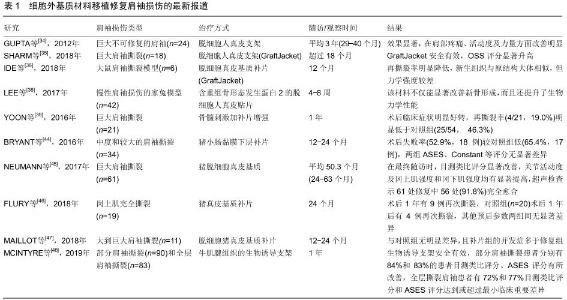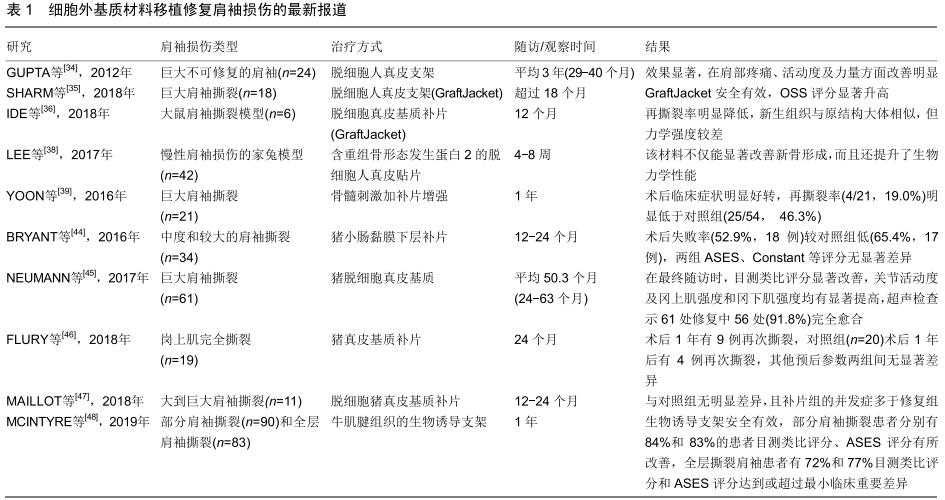Chinese Journal of Tissue Engineering Research ›› 2020, Vol. 24 ›› Issue (28): 4459-4464.doi: 10.3969/j.issn.2095-4344.2309
Previous Articles Next Articles
Research progress of biomaterials for repair of rotator cuff tear
Xin Pengfei1, Sun Youqiang2, Li Jie2, Chen Jianfa2, Deng Baogui2, Xiang Xiaobing2
1the First School of Clinical Medical Sciences, Guangzhou University of Chinese Medicine, Guangzhou 510405, Guangdong Province, China; 2Institute of Sports Medicine, First Affiliated Hospital of Guangzhou University of Chinese Medicine, Guangzhou 510405, Guangdong Province, China
-
Received:2019-10-22Revised:2019-10-24Accepted:2019-12-20Online:2020-10-08Published:2020-08-31 -
Contact:Xiang Xiaobing, Professor, Institute of Sports Medicine, First Affiliated Hospital of Guangzhou University of Chinese Medicine, Guangzhou 510405, Guangdong Province, China -
About author:Xin Pengfei, Master candidate, the First School of Clinical Medical Sciences, Guangzhou University of Chinese Medicine, Guangzhou 510405, Guangdong Province, China Sun Youqiang, MD, Attending physician, Institute of Sports Medicine, First Affiliated Hospital of Guangzhou University of Chinese Medicine, Guangzhou 510405, Guangdong Province, China -
Supported by:the Innovation and Hospital-Strengthening Foundation of the First Affiliated Hospital of Guangzhou University of Chinese Medicine, No. 2019QN12
CLC Number:
Cite this article
Xin Pengfei, Sun Youqiang, Li Jie, Chen Jianfa, Deng Baogui, Xiang Xiaobing . Research progress of biomaterials for repair of rotator cuff tear[J]. Chinese Journal of Tissue Engineering Research, 2020, 24(28): 4459-4464.
share this article

2.1 未经处理的人体自身组织移植材料 人体自身组织移植材料是指取材于人体自身组织且未经任何加工处理的材料,取材的组织有人体的阔肌膜、肱二头肌长头肌肌腱、腘绳肌肌腱等。根据组织来源不同可分为自体移植材料、未经处理的同种异体移植材料。自体移植材料因其有较好的生物性能,不易引起机体的炎症反应而被应用[13-14],且自体移植材料可以创建一个足够大小和强度的肌腱补片,以满足桥接肌腱缺损所必需的生物力学要求[15];其缺点在于不能恢复腱骨结合部位的正常结构,取材时会给身体带来二次伤害。MIHARA等[16]报道了5例不适宜初次修复的患者,使用自体髂胫束带骨瓣移植治疗肩袖撕裂,随访2年发现移植物更好地重建了肩袖,移植骨均与肱骨大结节融合,且临床疗效良好。ROSALES-VARO等[17]对比了自体阔筋膜移植增强缝合与未进行增强缝合治疗肩袖撕裂患者的疗效,结果发现增强组较未增强组在术后6个月疼痛方面有显著改善,而术后1年的随访显示两组Constant-Murley评分及疼痛评分无差异,非移植组的再撕裂数高于移植组,但差异无统计学意义。RHEE等[18]对比了关节镜下利用自体肱二头肌长头肌肌腱与同种异体真皮补片治疗巨大肩袖撕裂的效果,发现术后愈合率均不理想,但自体肱二头肌长头肌肌腱的治疗效果优于同种异体真皮皮肤移植,作者发现小圆肌的广泛脂肪浸润及肩胛下肌撕裂可能是影响移植组织愈合失败率的原因。随着肩袖脂肪变性的加重,再撕裂率会增加,而大部分肩袖撕裂都伴有慢性脂肪浸润[19]。有研究发现利用自体阔筋膜移植治疗肩袖巨大撕裂并冈下肌轻度脂肪退变有较好的临床疗效,但治疗巨大肩袖撕裂伴高度的冈上肌和冈下肌脂肪变性疗效却不佳[20-21]。未经处理的同种异体移植材料因移植后易导致机体的免疫反应及存在感染性疾病的风 险[22],近期对此的报道较少。 2.2 细胞外基质材料 细胞外基质材料是指将移植材料经过特殊处理去除材料中免疫成分,但保留原有三维结构及胶原蛋白的一种材料[23]。细胞外基质材料修复肩袖撕裂的作用主要是可以充填肩袖缺损,增强肌腱强度[24],还能促进新的腱骨界面形成,促进腱骨界面愈合,降低再撕裂率[25]。目前对于细胞外基质补片促进腱骨愈合的机制还不是很明确,可能与用于增强修复的补片组织减少了其余肩袖组织的应力、改善了局部力学环境有关[26]。最新的有限元分析表明,当增加2 mm额外补片时,撕裂口的应力降低[27]。修复机制也可能是血管内生的原因,因为植入物改善了向该区域输送修复成分的能力[28]。但有研究报道细胞外基质材料的弹性及韧性远低于正常肌腱[29],且其可能引起不利的炎症反应。宿主反应在很大程度上取决于物种和起源组织、细胞残留物的提取方法和灭菌技术[30]。PAN等[31]报道了经脱细胞处理的同种异体肌腱源性材料,没有合适的孔隙大小和孔隙率来促进细胞浸润。SMITH等[32]认为目前还没有研究出一种修复肩袖损伤最好的生物支架,因此设计的方向应该是在降低再撕裂率的基础上并发症最小化的生物修复材料。ZHENG等[33]最新报道了一种三维结构胶原支架具有与天然肌腱相似的胶原纤维三维结构,具有优越的力学性能,三维结构胶原支架提供了有利于细胞浸润的稳定宏观结构。CAI等[25]在一项随机对照试验中证实了三维胶原支架增强可有效治疗中度至巨大肩袖撕裂,显著改善功能,降低再撕裂率,且该技术还可促进新的腱骨形成,对腱骨愈合有显著作用。细胞外基质材料近几年应用较广泛,根据细胞外基质的物种来源大体可分为以下几种。 2.2.1 来源于人体组织 目前临床上常用的GraftJacket等,是来源于同种异体人源性真皮。GUPTA等[34]使用脱细胞人真皮支架治疗巨大肩袖损伤,临床效果显著。最新有研究用GraftJacket治疗巨大肩袖损伤,临床结果显示患者OSS评分显著提升,证实了该材料的有效性及安全性[35]。在最新的大鼠肩袖损伤模型中,利用GraftJacket补片移植6个月以后观察重建的肌腱-骨连接的组织学和生物力学强度,发现再撕裂率明显降低,新生组织与原结构大体相似,但细胞组织较差,重塑腱骨结合的生物力学强度仅为正常对照组的48%[36]。为促进肩袖补片移植后的愈合过程,需要在组织工程和术后康复方面取得进展。有研究通过测试7种常用支架的宏观性能和微观结构发现,现有的支架无法充分模拟人类冈上肌腱的力学性能,提出将合成支架的宏观力学性能与生物支架的微观力学性能相结合可能有助于改善患者预后[37]。LEE等[38]利用含重组骨形态发生蛋白2的脱细胞人真皮补片治疗慢性肩袖损伤家兔模型,发现该补片不仅能显著改善新骨形成,而且还提升了生物力学性能,如极限抗拉强度。YOON等[39]报道了21例巨大肩袖撕裂患者使用骨髓刺激加补片增强治疗(1组),54例患者使用传统修补方法治疗(2组),1年后随访发现两组临床症状均明显好转,两组在目测类比评分、SST、UCLA、CONSTANT、ASES评分上无显著差异,但1组术后再撕裂率(4/21,19.0%)显著低于2组(25/54,46.3%)。目前报道的同种异体人源性真皮移植材料大多有效且无明显并发症发生。一项最新的系统评价表明同种异体移植物的术后结果优于异种移植物[40]。 2.2.2 来源于猪的组织 来源于猪组织的细胞外基质材料取材较广泛,可来源于猪的小肠下黏膜、真皮、跟腱等组织。在较前的报道中已证实,来源于猪的小肠黏膜下层很少或基本不能改善患者症状,甚至会产生不利的后果[41-42],其中炎症反应是一个较为常见的并发症。GILBERT等[43]指出材料中猪DNA仍然存在,可能是引起炎症反应的一个原因。近期关于使用猪小肠黏膜下层补片的临床报道也较少,这可能与其高免疫原性有关,因此大多数学者达成共识:不推荐使用猪的小肠黏膜下层移植材料。最新的一项随机对照试验使用猪小肠黏膜下层补片开放性修补肩袖也支持了这一观点[44]。猪真皮移植材料目前临床上应用也较广泛,但最新的临床报道却得到了不一致的结果。NEUMANN等[45]使用猪脱细胞真皮基质异种移植修复肩袖损伤(n=61),平均随访时间为50.3个月,在最终随访时患者目测类比评分显著改善,关节活动度及冈上肌强度和冈下肌强度均有显著提高,超声检查示56例(91.8%)完全愈合。FLURY等[46]对比了单纯关节镜下修复(对照组)与关节镜下联合猪真皮基质补片修补肩袖(补片组)术后2年的临床及主观疗效,发现补片组(n=19)1年后有9例患者再次撕裂,对照组(n=20)1年后有4例患者再次撕裂,且两组间其他预后参数无显著差异,所以认为猪真皮异种移植并不能降低再撕裂的风险和改善肩部功能。MAILLOT等[47]比较了关节镜下不加补片的外科修复(修补组)、脱细胞猪真皮基质补片修补(补片组)与关节镜下清创并切除肱二头肌长头肌肌腱(清创组)3种方式治疗巨大肩袖撕裂的效果,结果发现修补组与补片组间无明显差异,且补片组的并发症多于修复组,因此作者不建议使用脱细胞猪真皮基质治疗巨大肩袖撕裂。有研究表明,经脱细胞处理的同种异体肌腱没有合适的空隙大小和空隙率来促进细胞的浸润生长,而市场上可用的合成支架在诱导肌腱分化方面不足,于是报道了一种以猪跟腱为源材料的三维结构胶原支架,在体外细胞培养24 h发现,肌腱干细胞在三维胶原支架上呈梭形的整齐排列,7 d后形成细胞间接触并沉积细胞外基质;在家兔体内肩袖修复模型中,三维胶原支架组12周移植后再生肌腱显示出更显著的胶原纤维微观结构和大直径,更好的排列和力学性能[33]。 2.2.3 来源于牛的组织 来源于牛组织的移植材料报道较少。最新一项研究使用牛肌腱组织生物诱导支架治疗90例部分肩袖撕裂和83例全层肩袖撕裂患者,分别在术后2周、6周、12周、6个月、1年对其进行随访,结果发现部分肩袖撕裂患者术后平均37.3 d能重返工作,分别 有84%和83%的患者目测类比评分、ASES评分有所改善,达到或超过了各项指标的最小临床重要差异;全层肩袖撕裂患者术后平均50.7 d能重返工作,72%和77%的患者目测类比评分和ASES评分达到或超过最小临床重要差异,显示了生物诱导支架的有效性和安全性[48]。 目前应用较广泛的细胞外基质材料见表1。 2.3 人工合成材料 人工合成材料是指使用化学方法合成的材料,根据材料是否能在体内降解可分为不可降解和可降解材料。有研究表明人造移植物具有较强的机械强度,质量稳定,疾病传播的风险最小,但植入的异物也有可能加大了感染、滑膜炎和骨关节炎的可能[49]。人工合成不可降解材料目前应用较多的有聚四氟乙烯、聚丙烯、聚酯等。CIAMPI等[50]对比了聚丙烯补片与单纯 切开修复和胶原补片治疗巨大肩袖撕裂的临床效果,术后随访36个月后发现聚丙烯补片组在肩部功能、强度、再撕裂率等方面明显改善。一项回顾性研究评价了人工合成不可吸收补片(聚丙烯单丝补片)联合肱二头肌长头肌腱治疗不可修复肩袖损伤的临床效果,术后36个月的随访发现患者疼痛及肩部功能明显改善,再撕裂率为15%(9/60),明显低于对照组,且在随访期间无任何不良反应的报道[51]。在一项小样本量长达近10年随访的研究中,使用聚四氟乙烯治疗肩袖损伤患者,末次随访时患者术后疼痛及肩部功能明显改善,所有的补片都保持原位[52]。人工合成可降解材料因其面临着不同聚合物降解的细胞毒性不同,且其降解机制的未知性,目前很少有临床报道其治疗肩袖撕裂的疗效,大多数研究都使用了动物模型。一项研究对静电纺技术制备的聚己内酯/Ⅰ型胶原纳米纤维取向性补片(实验组)与单纯聚己内酯纳米纤维补片(对照组)分别行电镜扫描测量纤维直径和孔隙率,并进行机械性能测试,此外还将两种补片与第3代兔肌腱干细胞联合培养,结果发现实验组补片的纤维直径显著小于对照组,孔隙率和纤维拉伸程度显著大于对照组,说明聚己内酯/Ⅰ型胶原纳米纤维具有优良的理化性能;并且发现聚己内酯/Ⅰ型胶原纳米纤维具有优良的细胞黏附功能、无细胞毒性[53]。ZHAO等[54]使用明胶-聚左旋乳酸治疗大鼠肩袖损伤,术后8周发现腱-骨界面糖胺聚糖染色显著增加,胶原组织明显改善。GUO等[55]使用聚左旋乳酸和硅酸钙磷酸盐复合膜治疗家兔肩袖撕裂,术后12周可见聚左旋乳酸/硅酸钙磷酸盐复合膜形成良好的肌腱-骨界面,证实了复合材料具有良好的生物性能、生物相容性及生物降解性,可以改善胶原组织,促进软骨和骨的形成。 "

|
[1] HASHIMOTO T, NOBUHARA K, HAMADA T. Pathologic evidence of degeneration as a primary cause of rotator cuff tear. Clin Orthop Relat Res.2003;(415):111-120.
[2] FEHRINGER EV, SUN J, VANOEVEREN LS, et al. Full-thickness rotator cuff tear prevalence and correlation with function and co-morbidities in patients sixty-five years and older.J Shoulder Elbow Surg. 2008;17(6):881-885.
[3] KIM M, TEEFEY SA, ZELIG A, et al. Shoulder Strength in Asymptomatic Individuals with Intact Compared with Torn Rotator Cuffs .J Bone Joint Surg Am.2009;91a(2):289-296.
[4] 冉北航,张芬,尹文芳.羽毛球运动中发生手腕和肩袖损伤的相关因素调查[J].中国临床康复, 2006,10(44):41-43.
[5] COLVIN AC, EGOROVA N, HARRISON AK, et al. National Trends in Rotator Cuff Repair.J Bone Joint Surg Am.2012;94a(3):227-233.
[6] JUDGE A, MURPHY RJ, MAXWELL R, et al. Temporal trends and geographical variation in the use of subacromial decompression and rotator cuff repair of the shoulder in England.Bone Joint J. 2014;96b(1): 70-74.
[7] PALONEVA J, LEPOLA V, AARIMAA V, et al. Increasing incidence of rotator cuff repairs--A nationwide registry study in Finland.BMC Musculoskelet Disord.2015;16:189.
[8] ELLMAN H. Diagnosis and treatment of incomplete rotator cuff tears. Clin Orthop Relat Res.1990;254:64-74.
[9] THON SG, O'MALLEY L 2ND, O'BRIEN MJ, et al. Evaluation of Healing Rates and Safety With a Bioinductive Collagen Patch for Large and Massive Rotator Cuff Tears:2-Year Safety and Clinical Outcomes.Am J Sports Med.2019;47(8):1901-1908.
[10] ALLEN GM. The diagnosis and management of shoulder pain.J Ultrason.2018;18(74): 234-239.
[11] BUNKER DL, ILIE V, ILIE V, et al. Tendon to bone healing and its implications for surgery . Muscles Ligaments Tendons J. 2014;4(3): 343-350.
[12] GALATZ L M, SANDELL L J, ROTHERMICH S Y, et al. Characteristics of the rat supraspinatus tendon during tendon-to-bone healing after acute injury.J Orthop Res.2006;24(3):541-550.
[13] CARPENTER JE, WENING JD, MELL AG, et al. Changes in the long head of the biceps tendon in rotator cuff tear shoulders.Clin Biomech. 2005;20(2):162-165.
[14] SANO H, KUMAGAI J, SAWAI T. Experimental fascial autografting for the supraspinatus tendon defect:Remodeling process of the grafted fascia and the insertion into bone.J Shoulder Elb Surg. 2002;11(2): 166-173.
[15] KIRCHER J, SCHMIDT F, HAWELLEK T, et al. Autologous bridging of rotator cuff tears with a hamstring tendon patch. A cadaver feasibility study and biomechanical testing.Clin Biomech. 2018;56(36-39.
[16] MIHARA S, FUJITA T, ONO T, et al. Rotator cuff repair using an original iliotibial ligament with a bone block patch: preliminary results with a 24-month follow-up period.J Shoulder Elb Surg.2016;25(7):1155-1162.
[17] ROSALES-VARO AP, GARCIA-ESPONA MA, RODA-MURILLO O. Outcomes of rotator cuff augmentation surgery with autologous fascia lata.Rev Esp Cir Ortop Traumatol.2018;62(3):157-167.
[18] RHEE SM, OH JH. Bridging Graft in Irreparable Massive Rotator Cuff Tears:Autogenic Biceps Graft versus Allogenic Dermal Patch Graft.Clin Orthop Surg.2017;9(4):497-505.
[19] CHUNG SW, KIM JY, KIM MH, et al. Arthroscopic repair of massive rotator cuff tears: outcome and analysis of factors associated with healing failure or poor postoperative function.Am J Sports Med. 2013;41(7):1674-1683.
[20] MORI D, FUNAKOSHI N, YAMASHITA F.Arthroscopic surgery of irreparable large or massive rotator cuff tears with low-grade fatty degeneration of the infraspinatus:patch autograft procedure versus partial repair procedure.Arthroscopy.2013;29(12):1911-1921.
[21] MORI D, FUNAKOSHI N, YAMASHITA F, et al. Effect of Fatty degeneration of the infraspinatus on the efficacy of arthroscopic patch autograft procedure for large to massive rotator cuff tears.Am J Sports Med.2015;43(5):1108-1117.
[22] KEW SJ, GWYNNE JH, ENEA D, et al. Synthetic collagen fascicles for the regeneration of tendon tissue.Acta Biomater.2012;8(10):3723-3731.
[23] BADYLAK SF, FREYTES DO, GILBERT TW. Extracellular matrix as a biological scaffold material:Structure and function.Acta Biomater. 2009; 5(1):1-13.
[24] SHEA KP, OBOPILWE E, SPERLING JW, et al.A biomechanical analysis of gap formation and failure mechanics of a xenograft-reinforced rotator cuff repair in a cadaveric model.J Shoulder Elb Surg.2012;21(8):1072-1079.
[25] CAI YZ, ZHANG C, JIN R L, et al. Arthroscopic Rotator Cuff Repair With Graft Augmentation of 3-Dimensional Biological Collagen for Moderate to Large Tears:A Randomized Controlled Study.Am J Sports Med.2018;46(6):1424-1431.
[26] SCHLEGEL TF, ABRAMS JS, BUSHNELL BD, et al. Radiologic and clinical evaluation of a bioabsorbable collagen implant to treat partial-thickness tears: a prospective multicenter study.J Shoulder Elb Surg.2018;27(2):242-251.
[27] BOKOR DJ, SONNABEND D, DEADY L, et al. Evidence of healing of partial-thickness rotator cuff tears following arthroscopic augmentation with a collagen implant:a 2-year MRI follow-up.Muscles Ligaments Tendons J.2016;6(1):16-25.
[28] ARNOCZKY SP, BISHAI SK, SCHOFIELD B, et al. Histologic Evaluation of Biopsy Specimens Obtained After Rotator Cuff Repair Augmented With a Highly Porous Collagen Implant. Arthroscopy.2017;33(2):278-283.
[29] CHAUDHURY S, HOLLAND C, THOMPSON MS, et al. Tensile and shear mechanical properties of rotator cuff repair patches.J Shoulder Elb Surg.2012;21(9):1168-1176.
[30] RICCHETTI E T, AURORA A, IANNOTTI J P, et al. Scaffold devices for rotator cuff repair. J Shoulder Elb Surg.2012;21(2):251-265.
[31] PAN J, LIU GM, NING LJ, et al. Rotator cuff repair using a decellularized tendon slices graft: an in vivo study in a rabbit model. Knee Surg Sport Tr A.2015;23(5):1524-1535.
[32] SMITH RDJ, CARR A, DAKIN SG, et al. The Response Of Tenocytes To Commercial Scaffolds Used for Rotator Cuff Repair.Eur Cells Mater.2016;31:107-118.
[33] ZHENG Z, RAN J, CHEN W, et al. Alignment of collagen fiber in knitted silk scaffold for functional massive rotator cuff repair.Acta Biomater. 2017;51:317-329.
[34] GUPTA AK, HUG K, BERKOFF DJ, et al. Dermal tissue allograft for the repair of massive irreparable rotator cuff tears.Am J Sports Med. 2012;40(1):141-147.
[35] SHARMA N, EL REFAIY A, SIBLY TF. Short-term results of rotator cuff repair using GraftJacket as an interpositional tissue-matched thickness graft.J Orthop. 2018;15(2):732-735.
[36] IDE J, TOKUNAGA T.Rotator cuff tendon-to-bone healing at 12 months after patch grafting of acellular dermal matrix in an animal model.J Orthop Sci.2018;23(2):207-212.
[37] SMITH RDJ, ZARGAR N, BROWN CP, et al. Characterizing the macro and micro mechanical properties of scaffolds for rotator cuff repair. J Shoulder Elb Surg.2017;26(11):2038-2046.
[38] LEE KW, LEE JS, KIM YS, et al. Effective healing of chronic rotator cuff injury using recombinant bone morphogenetic protein-2 coated dermal patch in vivo.J Biomed Mater Res B.2017;105(7):1840-1846.
[39] YOON JP, CHUNG SW, KIM JY, et al. Outcomes of Combined Bone Marrow Stimulation and Patch Augmentation for Massive Rotator Cuff Tears.Am J Sport Med.2016;44(4):963-971.
[40] STEINHAUS ME, MAKHNI EC, COLE BJ, et al. Outcomes After Patch Use in Rotator Cuff Repair . Arthroscopy.2016;32(8):1676-1690.
[41] IANNOTTI JP, CODSI MJ, KWON YW, et al. Porcine small intestine submucosa augmentation of surgical repair of chronic two-tendon rotator cuff tears - A randomized, controlled trial. J Bone Joint Surg Am.2006;88a(6):1238-1244.
[42] WALTON JR, BOWMAN NK, KHATIB Y, et al. Restore orthobiologic implant: not recommended for augmentation of rotator cuff repairs.J Bone Joint Surg Am.2007;89(4):786-791.
[43] GILBERT TW, FREUND JM, BADYLAK SF. Quantification of DNA in biologic scaffold materials.J Surg Res.2009;152(1):135-139.
[44] BRYANT D, HOLTBY R, WILLITS K, et al. A randomized clinical trial to compare the effectiveness of rotator cuff repair with or without augmentation using porcine small intestine submucosa for patients with moderate to large rotator cuff tears:a pilot study. J Shoulder Elb Surg.2016;25(10):1623-1633.
[45] NEUMANN JA, ZGONIS MH, RICKERT KD, et al. Interposition Dermal Matrix Xenografts: A Successful Alternative to Traditional Treatment of Massive Rotator Cuff Tears.Am J Sports Med.2017;45(6):1261-1268.
[46] FLURY M, RICKENBACHER D, JUNG C, et al. Porcine Dermis Patch Augmentation of Supraspinatus Tendon Repairs: A Pilot Study Assessing Tendon Integrity and Shoulder Function 2 Years After Arthroscopic Repair in Patients Aged 60 Years or Older.Arthroscopy. 2018;34(1):24-37.
[47] MAILLOT C, HARLY E, DEMEZON H, et al. Surgical repair of large-to-massive rotator cuff tears seems to be a better option than patch augmentation or debridement and biceps tenotomy: a prospective comparative study.J Shoulder Elb Surg.2018,27(9):1545-1552.
[48] MCINTYRE LF, BISHAI SK, BROWN PB, 3RD, et al. Patient-Reported Outcomes After Use of a Bioabsorbable Collagen Implant to Treat Partial and Full-Thickness Rotator Cuff Tears. Arthroscopy. 2019;35(8): 2262-2271.
[49] MCCORMACK RA, SHREVE M, STRAUSS EJ.Biologic augmentation in rotator cuff repair--should we do it, who should get it, and has it worked? Bull Hosp Jt Dis.2014;72(1):89-96.
[50] CIAMPI P, SCOTTI C, NONIS A, et al. The Benefit of Synthetic Versus Biological Patch Augmentation in the Repair of Posterosuperior Massive Rotator Cuff Tears A 3-Year Follow-up Study.Am J Sports Med. 2014;42(5):1169-1175.
[51] VITALI M, CUSUMANO A, PEDRETTI A, et al. Employment of synthetic patch with augmentation of the long head of the biceps tendon in irreparable lesions of the rotator cuff: our technique applied to 60 patients.Tech Hand Up Extrem Surg.2015;19(1):32-39.
[52] SHEPHERD HM, LAM PH, MURRELL GA. Synthetic Patch Rotator Cuff Repair:A 10-year Follow-Up.Shoulder Elbow.2014;6(1):35-39.
[53] GAO C, LI C, XU Y, et al. Electrospun polycaprolactone/collagen type Ⅰnanofibers oriented patch for rotator cuff repairing.Zhongguo Xiu Fu Chong Jian Wai Ke Za Zhi.2019; 33(5):628-633.
[54] ZHAO S, XIE X, PAN G, et al. Healing improvement after rotator cuff repair using gelatin-grafted poly(L-lactide) electrospun fibrous membranes. J Surg Res.2015;193(1): 33-42.
[55] GUO JS, SU W, JIANG J, et al. Enhanced tendon to bone healing in rotator cuff tear by PLLA/CPS composite films prepared by a simple melt-pressing method: An in vitro and in vivo study.Compos Part B-Eng.2019;165(526-536.
[56] HURLEY ET, FAT DU, MORAN CJ, et al. The Efficacy of Platelet-Rich Plasma and Platelet-Rich Fibrin in Arthroscopic Rotator Cuff Repair:A Meta-analysis of Randomized Controlled Trials.Am J Sports Med. 2019;47(3):753-761.
[57] KIM YS, SUNG CH, CHUNG SH, et al. Does an Injection of Adipose-Derived Mesenchymal Stem Cells Loaded in Fibrin Glue Influence Rotator Cuff Repair Outcomes? A Clinical and Magnetic Resonance Imaging Study.Am J Sports Med.2017;45(9):2010-2018. |
| [1] | Liu Peidong, Feng Jiangfeng, Xu Wenjie, Xu Xiaodong, Yang Ziquan . Bioinformatics analysis of gene expression profile and key pathways related to fatty infiltration after rotator cuff injury [J]. Chinese Journal of Tissue Engineering Research, 2021, 25(11): 1773-1778. |
| Viewed | ||||||
|
Full text |
|
|||||
|
Abstract |
|
|||||